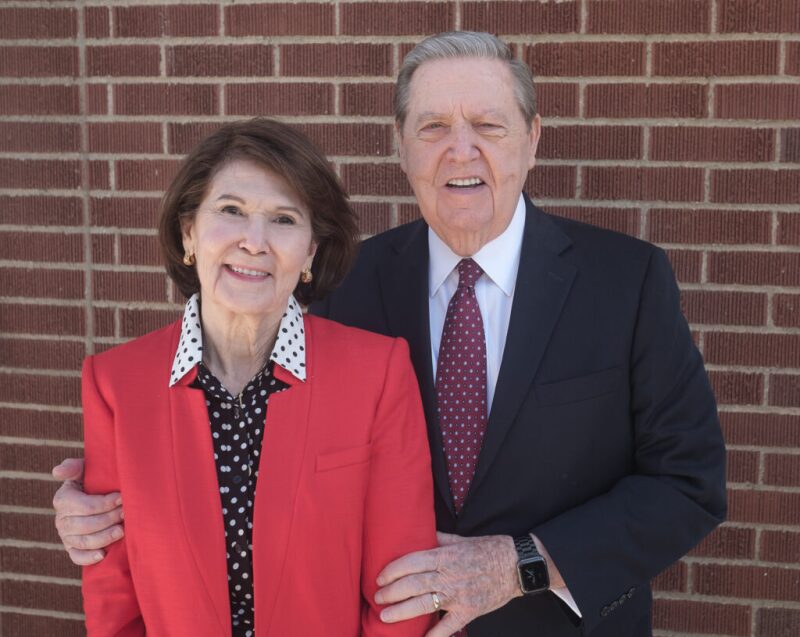In a special two-part episode of the Church News podcast, Elder Jeffrey R. Holland and Sister Patricia T. Holland shared intimate stories of faith and unique leadership opportunities they’ve each had throughout their decades of Church service. The episodes were guest hosted by Sister Sheri Dew, former member of the Relief Society general presidency and current executive vice president of Deseret Management Corporation.
Here are a few of the more personal stories the Hollands shared in the interview.
Sheri Dew: Let’s go back to when you were a general officer, a counselor to Sister Ardeth Kapp, who was then the General Young Women President—as you’ve looked back at that service when you were pretty young, what lessons or insights have you carried forward with you, did you learn then that you’ve brought forward with you since that time?
Sister Patricia T. Holland: I learned a lot from Sister Kapp, for one thing. And to be called a serve on the general level was such an honor to me, but it took me to my knees. It was really quite overwhelming. Jeff had a, he was a busy, busy young president, as you say, and my focus in my life, my whole life, was to put my children first. So they were full-time, and then this seemed like such a full-time calling. And I was only going to go up one day a week, but we decided that the program needed to have more of a spiritual focus, and the program that was currently there was, just somehow didn’t hit the right notes for me, for her, for the board. We just felt like we needed something more spiritual for the young women to focus on, because what you focus on is what you become. And young women don’t have these values yet, they don’t have faith and divine nature and all of that. So that’s what we decided. It needed to be it’s focal, and have them repeat it enough that it really went into their hearts and souls and spirits. And we were absolutely left beyond compare. [We] can’t believe the miracles that had to take place to have a program make it through all that it had to do to become part of the Church. It was like 18 months.
Sheri Dew: A lot of really interesting things happened during your term [at BYU] ... but the Jerusalem Center is surely one of the pinnacle moments. ... What can you tell us about the range of challenges that that took?
Elder Jeffrey R. Holland: I gave a talk at BYU not long ago. We had a little 50-year anniversary of how long that program has been in place, and I gave a talk about the miracles that I had seen, and I think the number—large or small, some larger than others—was something like 35 things that had to happen in order for that place to exist, and if any of them had gone south, we wouldn’t have had it, and it really is a miracle. And I can’t regale you here with the reasons why we had no right to be where we are. I’ll give you this much of a little snippet: When we wanted to show President Kimball the property that we wanted to get, we’d looked all over. We’d looked everywhere and in the area for property, because we lived in hotels, we lived in kibbutz, we lived everywhere. We needed our own facility. So we had a little ugly piece of property, little L-shaped piece of property in a gully with some goats in it, but there was nothing else. So we took President Kimball—we wanted to take President Kimball to look at it. He was not really well ... so he sent President Tanner; and President Tanner, brilliant, wonderful man that he was, took a quick look at this piece of property, and you could tell by the look on his face that we weren’t going to get that piece. He was not interested in that, and he started to walk. He walked up this gully and over across onto the brow of the hill, looking out over the Old City. The most spectacular view of the Old City, anywhere in that immediate area, the East Jerusalem. And he turned to the group and said, “This is the piece. Get this piece.” Well, he could have said, “If you were in London, get Buckingham Palace.” I mean, this was a place where the Supreme Court Building was going to be built. It was a green zone, wasn’t going to be any building on it, that’s why the Supreme Court Building had been built. There was concern about archeological digs. It was contested because it was appropriated Arab property from East Jerusalem; but Israel, the Jewish side of the community, was the governing body so... I can’t begin to list all of the problems why this was not going to be available. ... And about halfway through it, he said, “Don’t tell me your problems. Just get the property.” And walked off. So anyway, there we are. That’s the property we’re on, some many months later, and as a tribute to a lot of people who work very hard. ... But one miracle after another, the right person at the right time, the right committee in the right hour. ... We had the building two-thirds of the way up before we got a building permit. Now, we could have been told to shut down. They would have had every right to say, “You were ahead of the game. You were too fast.” We weren’t illegal, we were just eager; but they didn’t. We were there, and we’ve been there for 50 years now. ... It’s a wonderful thing for the students of BYU to have a Jerusalem Center Project.
You can read the full transcripts on Church News or listen to the podcast episodes in the player below.

